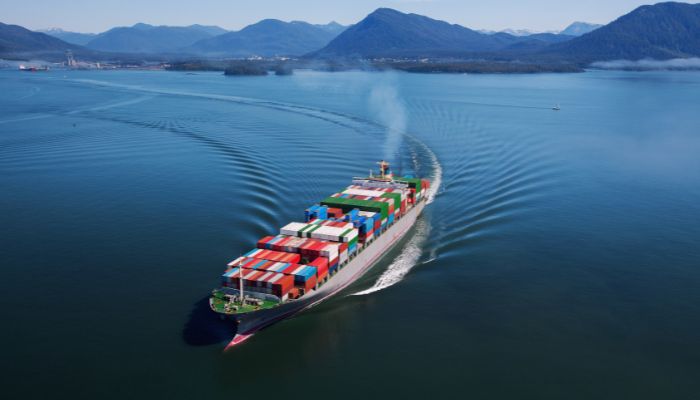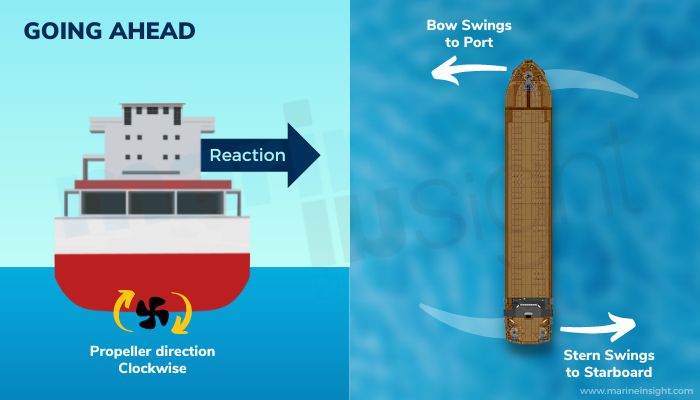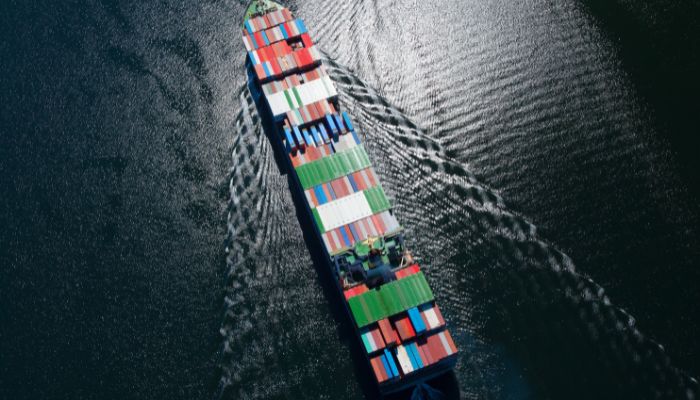

Thrust alludes to the force that pushes or spurs a body to move in a particular direction. Regarding ships, Thrust can be defined as the propulsive force that drives the vessel through the water against the resistive forces, mostly hydrodynamic.
The answer is – the propeller or the propulsive device associated with the vessel.
How?
Again, in simple words, the Thrust is derived from the propeller’s action that is caused due to the rotational motion of the blades, which is translated into linear motion. More specifically, the torque stemming from the rotational motion of the blades is converted into Thrust that produces a large fraction of dynamic force to the surrounding water medium, which in turn, impels the vessel due to the resultant reaction (Newton’s third law).


Moreover, there is also an interplay of hydrodynamic principles, including the pressure differentials about the blades, which affect the flow oncoming to the propeller. The propeller is driven by the continuous power supply from the main engine, where electrical and mechanical power is converted into rotational motion through a linkage of intermediate members like the crankshaft, intermediate shaft, stern tube shaft, and gearbox.
For unconventional modes of propulsion like propulsors and so on, the mechanism of power supply and transmission may be different. Still, the underlying principle remains the same: imparting a force on the adjoining water medium, which causes the body to move in the desired direction.
Now, for all practical purposes, we are familiar with the concept that the propeller or propulsor action causes the vessel to move either forward or astern (due to reverse or astern thrust) direction. This is mostly true, but the physics of action is a bit more complicated than that.
The force which drives the vessel in a particular direction is essentially the axial or longitudinal component of the resultant Thrust derived from propeller action on the water.
Returning to the basics of propulsion, it is important to know that the overall Thrust produced due to the propeller action on water is multi-directional in nature, like most other physical forces caused due to external means. However, the axial component of force is the predominant component that triggers the vessel to move ahead or astern, making the net effect of motion in a linear sense.
The smaller component of this Thrust, which is the one acting in the direction perpendicular to the vessel’s motion (the y-component when perceived in a conventional reference coordinate system), is what we call the transverse Thrust.
The effect of this component is not very significant in the resultant motion of the vessel but can be somewhat found from the initial tendencies of motion of the vessel. In a more technical sense, this transverse Thrust can be attributed to the collective interaction between the hull, propeller, and, up to some extent, the rudder.
Let us look at this interesting phenomenon in detail. For our better understanding, we take the simplest case of a conventional single-screw vessel with a right-handed propeller, that is, the clockwise motion of the blades, when viewed from the aft, causes the vessel to move in a forward direction, that is, in the direction of its bow. Conversely, from the same position of reference, a left-hand motion or a counterclockwise motion of the same set of blades causes the astern Thrust or the tendency of the vessel to move aftward. Now, with regard to transverse Thrust, two cases arise:


When the vessel moves in a forward direction, which is the most common case, the propeller taken for consideration moves in a clockwise or a righthand sense when viewed from behind. Due to the action of the blade forces in the slipstream of the propeller, there is a high degree of pressure on the starboard side (as the principal action of the propeller blades is towards the right or clockwise direction).
Furthermore, during the initial stages, when the engine power is high, but the resultant speed of the vessel is low, that is, the vessel is gradually accelerating, and the axial Thrust is still not very high enough, the transverse component of the Thrust is more pronounced. This induces the stern side to turn towards the starboard. This means the bow now turns in the anti-clockwise direction, which is towards the port. This entire couple takes place at the pivot point of the vessel at that time.
Now, as we know, for all practical purposes, for conventional vessels moving ahead, the pivot point is located towards the bow (1/3rd to 1/4th distance of length from the bow) and vice-versa. When a ship is at rest, the pivot point is more or less centred towards the midships.
Look at the below figure. The moment arm or the linear distance between the point of action and the pivot point is way larger in this case with respect to the stern as compared to the bow.
Hence, as per the coupling equation for balance:
Fb X Db + Fs X Ds = M
Where the suffixes b and s stand for the bow and stern, respectively. Fb essentially means the force component or the transverse Thrust acting on the front end or bow. Similarly, Fs stands for the thrust component acting on the aft end or the stern. Db and Ds are the distances from the point of action from the pivot point for the bow and stern, respectively. M is the resultant or net unbalanced moment.
Once again, PP, as shown in the figure, stands for the pivot point or the moment centre where the net coupling action is taking place.
Hence, from the first principles, another moment is created at the bow end. From Newton’s third law again, the transverse Thrust at the bow is equal to that at the stern, which means Fb=Fs. Now, as per the coupling equation, as the value of Ds > Db, that is, the moment arm or lever, as described, is much more at the stern as compared to the bow, the moment acting in the bow direction, that is Fb X Db, is smaller as compared to that of the moment at the stern, the difference being the significantly larger moment arm. So, for a given moment resultant moment M, the product Fb X Db, the moment at the bow, is smaller than the moment at the stern, Fs X Ds.
Moreover, at this juncture, the action of the rudder also comes into play. When the vessel is moving ahead, the rudder is directly in the wash of the propeller action. Simplifying this hydrodynamic term, the rudder is under the influence of the propeller-induced water flow, which is predominantly backward in the axial sense.
Thus, the stream of water flow acting from the propeller motion, which creates the forward Thrust, is overridden or compensated by the rudder directly in its wake. So, if the rudder angle is suitably and steadily maintained, it proves effective in cancelling the transverse thrust effects at the stern. Now, the lesser this value of initial transverse Thrust generated at the aft, the lesser the resultant moment, and this translate to a further reduced force at the bow, tending to turn it portside even lesser.
Thus, for all practical purposes, it can be said that, FORTUNATELY, the effects of transverse Thrust when the vessel is moving forward are not significant and can be ignored if it does not prove to be very much interfering with the vessel’s heading and overall propulsive efficiency.
Now, what happens in the reverse case? As expected, the opposite phenomenon. For the same propeller, the flow dynamics and pressure patterns are reversed, and the transverse Thrust is created at the stern in the opposite direction, that is, port in our case.
Critically, for reverse motions, the pivot point of the vessel is now centred close to the stern region. Again, refer to the below figure. For an initial transverse thrust directed towards the port at the stern for our right-handed propeller, the bow now tends to turn in the clockwise sense, that is, towards the starboard to complete the moment couple. The position of the point of action of this couple, that is, the pivot point, is now very crucial. Now, Db > Ds, which means the moment arm from the bow is greater as compared to from the stern, thanks to the location of the pivot point.
So, taking individual moments, the product Fb X Db is higher at the bow in this case.
Furthermore, the rudder action is not fully effective in this scenario; thus, the effects are increased further. In other words, the steering effects of the rudder are not sufficient enough to suppress the turning action of the transverse thrust component arising from the interaction of the propeller-induced flow and the hull.
Also, due to the hydrodynamics of the flow and the propeller, during an astern move, the pressure build-up on the starboard aft ward part of the hull is quite large. Hence, the transverse Thrust is quite large towards the port at the stern, and so is the moment produced. As Fb=Fs, the transverse Thrust at the bow is also higher proportionally during an astern move. This high value of Thrust, coupled with the larger moment arm or lever, creates a significantly high value of turning moment at the bow region (towards the starboard in our case).
Henceforth, for all practical purposes, when a vessel is going astern, the effects of transverse Thrust are higher. Thus, there is a significant tendency for the vessel’s heading to turn or drift sideways (towards starboard for a conventional right-handed propeller).
Other than the two important cases described above, other factors affect the value or magnitude of the transverse Thrust irrespective of the direction of motion. As already mentioned above, the value of the transverse Thrust is the highest when a vessel is at low speeds or starting from rest.
This is because, during these spans of time, the torque produced from the propeller action is more significantly expended in the transverse component of the Thrust as compared to the axial component, as the heading of the vessel is still at lesser speeds. Thus, at slow speeds, there is a higher tendency of the vessel to turn or change its heading as compared to steady higher speeds when there is a continuously high value of axial Thrust to move the vessel ahead or astern, overcoming the visible effects of transverse Thrust.


Therefore, the highest pronounced effects of the transverse Thrust are when the vessel is moving astern at low speeds.
For all practical purposes, for a vessel moving astern, the average propulsive power of the propeller consumed in the transverse Thrust for a conventional, sea-going commercial ship varies between 10-15 %.
The depth of the water also plays a crucial role. The effects of heading or turning due to transverse Thrust are more pronounced in shallow water than in deeper waters due to hydrodynamic effects on the propeller.
The weather and sea states also play a role. The maximum effects of the transverse Thrust can be seen in calm and undisturbed waters and conducive weather conditions. During rough conditions, the entire dynamics of the water and the erratic nature of the wind forces create a total state of disorder beyond the possible ways to predict and estimate the correct effects of transverse Thrust.
Transverse Thrust is sometimes an issue, especially during reverse turns, as mentioned, the heading can often be altered. So, other than applying higher power to attain higher speeds, the rudder angle is often altered accordingly by masters and navigators. For instance, when a vessel is reversing and is required to maintain a more or less fixed trajectory, the rudder angle is often given a hard turn towards the port side to cancel or compensate for the effects of turning starboard, as mentioned above for a right-handed propeller, often at the expense of higher power.
Transverse Thrust is not always a negative aspect and is often useful. During operations like anchoring or berthing, the transverse Thrust is often used to advantage by navigators and merchants by intentionally having an astern move. Often during operations like deep-sea cable-laying, transverse Thrust is often useful.
You Might Also Like To Read-
Disclaimer: The authors’ views expressed in this article do not necessarily reflect the views of The Marine Learners. Data and charts, if used, in the article have been sourced from available information and have not been authenticated by any statutory authority. The author and The Marine Learners do not claim it to be accurate nor accept any responsibility for the same. The views constitute only the opinions and do not constitute any guidelines or recommendations on any course of action to be followed by the reader.
The article or images cannot be reproduced, copied, shared, or used in any form without the permission of the author and The Marine Learners.










We believe that knowledge is power, and we’re committed to empowering our readers with the information and resources they need to succeed in the merchant navy industry.
Whether you’re looking for advice on career planning, news and analysis, or just want to connect with other aspiring merchant navy applicants, The Marine Learners is the place to be.